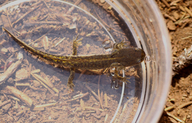|
Ambystoma macrodactylum Baird, 1850
Long-toed Salamander, Eastern Long-Toed Salamander, Santa Cruz Long-Toed Salamander, Northern Long-Toed Salamander, Western Long-Toed Salamander, Southern Long-Toed Salamander Subgenus: Xiphonura | family: Ambystomatidae genus: Ambystoma |
| Species Description: Baird, S. F. (1850 "1849"). Revision of the North American tailed-batrachia, with descriptions of new genera and species [Including: Descriptions of four new species of North American salamanders, and one new species of scink, pp. 292–294]. Journal of the Academy of Natural Sciences of Philadelphia. Series 2(1), 281–294. | |
 © 2010 Mark V. Leppin (1 of 142) |
|
|
|
Description Ambystoma macrodactylum columbianum A. m. croceum, A. m. krausei, A. m. macrodactylum, A. m. sigillatum are subspecies. Distribution and Habitat Country distribution from AmphibiaWeb's database: Canada, United States U.S. state distribution from AmphibiaWeb's database: California, Idaho, Montana, Oregon, Washington Canadian province distribution from AmphibiaWeb's database: Alberta, British Columbia
Life History, Abundance, Activity, and Special Behaviors Trends and Threats Possible reasons for amphibian decline General habitat alteration and loss Comments See other subspecies accounts at www.californiaherps.com: A. m. croceum and A. m. sigillatum.
References
Beneski, J. T. Jr., Zalisko, E. J., and Larsen, J. H. (1986). ''Demography and migratory patterns of the Eastern Long-toed Salamander Ambystoma macrodactylum columbianum.'' Copeia, 1986, 398-408. Blaustein, A. R., Kiesecker, J. M., Chivers, D. P., and Anthony, R. G. (1997). "Ambient UV-B radiation causes deformities in amphibian embryos." Proceedings of the National Academy of Sciences of the United States of America, 94(25), 13735-13737. Petranka, J. W. (1998). Salamanders of the United States and Canada. Smithsonian Institution Press, Washington D.C. and London. Sessions, S. K., and Ruth, S. B. (1990). ''Explanation for naturally occurring supernumerary limbs in amphibians.'' Journal of Experimental Zoology, 254, 38-47. Stebbins, R.C. (1951). Amphibians of Western North America. University of California Press, Berkeley. Tighe, K.A. (2023). Catalog of type specimens of recent Caudata and Gymnophiona in the National Museum of Natural History, Smithsonian Institution. Smithsonian Contributions to Zoology 654. Originally submitted by: Lauren M. Chan (first posted 1999-09-28) Edited by: Vance T. Vredenburg and Duncan Parks, Kevin Gin (2023-08-11) Species Account Citation: AmphibiaWeb 2023 Ambystoma macrodactylum: Long-toed Salamander <https://amphibiaweb.org/species/3840> University of California, Berkeley, CA, USA. Accessed Jun 1, 2025.
Feedback or comments about this page.
Citation: AmphibiaWeb. 2025. <https://amphibiaweb.org> University of California, Berkeley, CA, USA. Accessed 1 Jun 2025. AmphibiaWeb's policy on data use. |




 Raffaëlli Account
Raffaëlli Account Map of Life
Map of Life